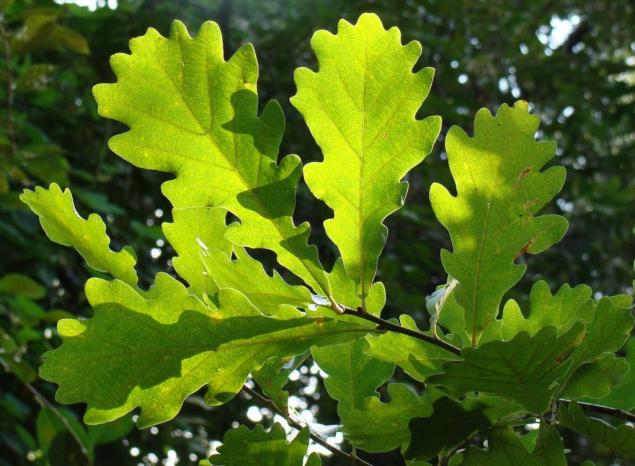608
Scientists have created a sodium rechargeable battery with oak leaf
Find ways to create a battery of sodium instead of lithium, took a somewhat unexpected turn when scientists at the University of Maryland and the National Center for Nanoscience and Technology of Beijing found that baked oak leaf, filled with sodium, made effective negative pole for the pilot version of the battery. < br>

As anyone who has ever done the battery out of a lemon (or potatoes), remember to do a battery of organic matter is certainly possible, and it could play a role in the development of a workable battery sodium-based.
Sodium theoretically should contain more charge than lithium, but in practice it can not withstand many cycles of charge and discharge. One of the stumbling blocks was the search for a suitable material for the anode, which is compatible with sodium. Graphite, which is used in lithium-ion batteries are not suitable, since sodium ions are much larger ion diameter than lithium. You can use graphene, but it is time-consuming and expensive to produce.
Early experiments included other sources of biomass, such as peat, banana peel, peel and melon, but they require additional processing and coating.
"The natural form of the sheet already corresponds to the structure of the battery: a small surface area, which reduces defects, many small structures located close to each other, which increases the space; and internal structure of the desired size and shape to be used with a sodium electrolyte, "said Shen Fei (Fei Shen), a student working on a project.
Initially dry sheet scientists treated using pyrolysis, baking it at 1000 ° C (1832 ° F) for one hour in an environment devoid of oxygen to burn off all but the carbon structures. To remove other inorganic impurities which may interfere with the electrochemical processes, they are immersed in a hydrogen chloride sheet for 6 hours.
The result is charred sheet still strewn on the lower side of the cell, which typically allows the sheet to absorb water and to carry out the exchange of gases. The charred state of the pores of the sheet more than suitable for the absorption of sodium electrolyte. carbon layers on thick outer part of the plate took the form of layers of nanostructured carbon-absorbing sodium, which carries a charge. In his state of the charred top of the sheet is flat, dense and suitable as a current collector in the plane of the electrochemical reactions.
The team used a battery the size of a coin, with sodium plates as electrodes for comparison, and the list has proved to be an effective anode for sodium batteries, capable of storing 360 mAh per gram of its own weight.
the anode sheet was tested in several rounds and proved to be stable, retaining 90 percent of capacity after 200 cycles. It is interesting to note that the charging efficiency also remains relatively high at around 75 percent, which scientists attribute the low formation of SEI (solid electrolyte interphase boundary) due to the small surface area of the membrane sheet.
"To create the battery, we tried other natural materials such as wood fiber," said Xu Lyangbing (Liangbing Hu), Associate Professor, Department of Materials Science and Engineering and research scientist at the University of Maryland Center. "Leaf is designed by nature to store energy for subsequent use, as well as using the leaves so you can create environmentally friendly large-scale energy storage»
. The researchers also experimented with a few leaves, connected to each other and plan to test different types of leaves, leaves to find the best properties for energy storage. They say that so far they have no plans to commercialize their ideas.

As anyone who has ever done the battery out of a lemon (or potatoes), remember to do a battery of organic matter is certainly possible, and it could play a role in the development of a workable battery sodium-based.
Sodium theoretically should contain more charge than lithium, but in practice it can not withstand many cycles of charge and discharge. One of the stumbling blocks was the search for a suitable material for the anode, which is compatible with sodium. Graphite, which is used in lithium-ion batteries are not suitable, since sodium ions are much larger ion diameter than lithium. You can use graphene, but it is time-consuming and expensive to produce.
Early experiments included other sources of biomass, such as peat, banana peel, peel and melon, but they require additional processing and coating.
"The natural form of the sheet already corresponds to the structure of the battery: a small surface area, which reduces defects, many small structures located close to each other, which increases the space; and internal structure of the desired size and shape to be used with a sodium electrolyte, "said Shen Fei (Fei Shen), a student working on a project.
Initially dry sheet scientists treated using pyrolysis, baking it at 1000 ° C (1832 ° F) for one hour in an environment devoid of oxygen to burn off all but the carbon structures. To remove other inorganic impurities which may interfere with the electrochemical processes, they are immersed in a hydrogen chloride sheet for 6 hours.
The result is charred sheet still strewn on the lower side of the cell, which typically allows the sheet to absorb water and to carry out the exchange of gases. The charred state of the pores of the sheet more than suitable for the absorption of sodium electrolyte. carbon layers on thick outer part of the plate took the form of layers of nanostructured carbon-absorbing sodium, which carries a charge. In his state of the charred top of the sheet is flat, dense and suitable as a current collector in the plane of the electrochemical reactions.
The team used a battery the size of a coin, with sodium plates as electrodes for comparison, and the list has proved to be an effective anode for sodium batteries, capable of storing 360 mAh per gram of its own weight.
the anode sheet was tested in several rounds and proved to be stable, retaining 90 percent of capacity after 200 cycles. It is interesting to note that the charging efficiency also remains relatively high at around 75 percent, which scientists attribute the low formation of SEI (solid electrolyte interphase boundary) due to the small surface area of the membrane sheet.
"To create the battery, we tried other natural materials such as wood fiber," said Xu Lyangbing (Liangbing Hu), Associate Professor, Department of Materials Science and Engineering and research scientist at the University of Maryland Center. "Leaf is designed by nature to store energy for subsequent use, as well as using the leaves so you can create environmentally friendly large-scale energy storage»
. The researchers also experimented with a few leaves, connected to each other and plan to test different types of leaves, leaves to find the best properties for energy storage. They say that so far they have no plans to commercialize their ideas.























